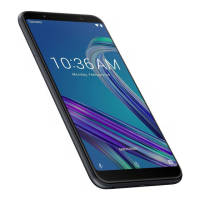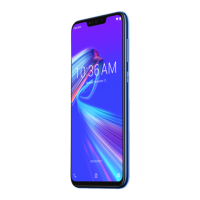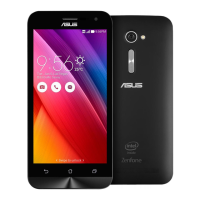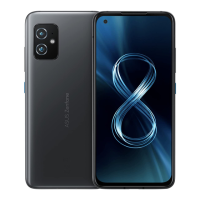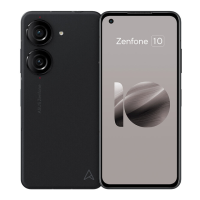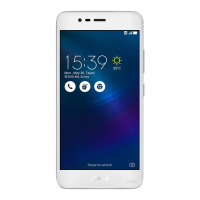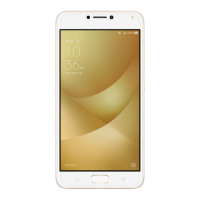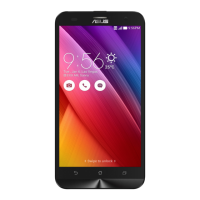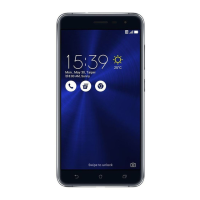Do you have a question about the Asus ZenFone Max Plus M1 and is the answer not in the manual?
Provides essential safety instructions for device usage.
Instructions for safe and environmentally friendly disposal of the device and battery.
Alerts about potential health risks associated with the device.
An introduction to the ASUS ZenUI interface and its features.
Guides on preparing and setting up the ASUS phone.
Step-by-step instructions for inserting a nano SIM card into the device.
Step-by-step instructions for removing a nano SIM card from the device.
Instructions on how to insert a memory card into the device.
Instructions on how to remove a memory card from the device.
Guidance on properly charging the ASUS phone, including safety precautions.
Procedures for powering the device on, off, and entering sleep mode.
Steps for initial device setup, including account configuration.
Advice on extending battery life through various settings and usage habits.
Explains basic touch gestures for navigating the phone interface.
Overview of features accessible from the Home screen.
Details on the main Home screen interface and its interactive elements.
Explains the meaning of various icons displayed on the status bar.
How to access and customize quick settings for frequent tasks.
How to view and manage system notifications and alerts.
Customization options for the Home screen, including widgets and wallpapers.
Adds shortcuts for quick access to often-used or favorite widgets.
Create folders to organize app shortcuts on your Home screen.
Instructions for applying and customizing wallpapers on the Home screen.
Steps to select and apply a wallpaper to the screen.
How to set up animated wallpapers for a dynamic screen.
Options to extend Home screen, change effects, icons, and alignment.
How to enable and use the simplified interface for easier navigation.
Step-by-step guide to activate the Easy mode feature.
How to add app shortcuts to the Home screen in Easy mode.
Steps to remove app shortcuts from the Home screen.
How to add frequently used contacts to the Home screen in Easy mode.
Steps to remove contacts from the Home screen in Easy mode.
How to turn off the Easy mode feature.
Information on setting up and using Kids mode for parental controls.
Step-by-step guide to activate and configure Kids mode.
Guide to configuring the device's date, time, and time zone settings.
How to customize sounds for calls, notifications, and system alerts.
Overview of the device's lock screen functionality.
Steps to change lock screen settings and options.
How to set up customizable shortcut buttons on the lock screen.
Information about the fingerprint sensor for unlocking and security.
Setting up fingerprint ID during the initial phone setup.
Detailed steps to configure fingerprint unlock via the Settings menu.
Information on using face recognition to unlock the device.
Steps to set up face unlock through the device’s settings.
Features and customization options for the on-screen keyboard.
How to adjust the size of the ZenUI keyboard for better usability.
Functions for cutting, copying, and pasting text using the keyboard.
Guide to using the Chrome browser for web browsing and synchronization.
How to open the Chrome browser application.
How to share web pages via email, cloud, or Bluetooth.
Instructions for saving and accessing favorite web pages.
Steps to clear browsing history, cache, and cookies.
Setting up and using the Gmail app for email communication.
Managing events and reminders using the Google Calendar app.
Step-by-step guide to create new events in Google Calendar.
How to modify or delete existing events in Google Calendar.
Instructions for setting up reminders in Google Calendar.
How to manage existing reminders in Google Calendar.
Features and usage of the messaging application.
Steps to compose and send SMS/MMS messages.
How to respond to incoming messages.
Managing files and data on the device's storage.
Overview of cloud storage options and services.
Information on using ASUS WebStorage for cloud storage.
Accessing help and support for ZenUI apps.
Features related to making calls and managing SIM cards.
Information on managing and using two SIM cards simultaneously.
How to assign custom names to SIM cards for identification.
Setting preferred SIMs for voice calls, SMS, and data.
How to assign a SIM for making phone calls.
How to assign a SIM for sending SMS messages.
How to assign a SIM for mobile data usage.
Various methods and steps for initiating phone calls.
How to open the Phone application.
Steps to dial a number directly using the Phone app.
How to dial extension numbers with prompts.
Automatically dialing extension numbers with pauses.
Using Smart Dial to quickly find and call contacts.
Making calls directly from the Contacts list.
How to call contacts added to the Favorites list.
How to handle incoming calls, including answering and rejecting.
Methods for answering or rejecting incoming calls.
Overview of accessing and using call history.
Adding numbers from call logs to the contacts list.
Steps to redial the most recent outgoing call.
Features available during an active call, like mute and speakerphone.
Controlling the microphone during a call.
Enabling or disabling the speakerphone.
Placing an active call on hold.
Adding participants to an ongoing call.
Recording active phone calls.
Handling more than one call simultaneously.
Detailed steps for recording phone conversations.
Organizing and managing contact information.
Customizing how contacts are displayed and sorted.
Personalizing your contact profile information.
Steps to add new contacts to the device.
Adding extension numbers to contact entries.
Editing contact details, adding photos, and setting ringtones.
Bringing contacts from other sources into the device.
Saving contacts to external storage or other accounts.
Blocking unwanted calls and messages.
Procedures to add contacts or numbers to the block list.
Removing contacts or numbers from the block list.
Integrating social media accounts with contacts.
How to sync social network contacts for better integration.
Using the Google Messenger app for messaging.
Connecting and using a headset with the device.
Inserting the 3.5mm headset jack into the audio port.
Using the app for streaming music and managing music libraries.
Steps to sign in and configure Google Play Music.
Accessing and using the camera for photos and videos.
Methods to open the device's camera application.
Using volume keys to launch the camera quickly.
Overview of camera interface and controls.
Enabling and using location tagging for photos.
Exploring enhanced camera functionalities like Beauty and GIF animation.
Using the Beauty feature for live facial enhancements.
How to take photos with Beauty mode activated.
Editing existing photos with Beauty enhancements.
Creating GIF animations from photos.
Steps to capture photos for GIF animation.
Capturing wide-angle panoramic photos.
Guide to taking panoramic shots.
Creating time-lapse videos from captured stills.
Steps to record time-lapse videos.
Managing and viewing photos and videos.
Accessing media from external sources in the Gallery.
Displaying location details for captured photos.
Options for sharing photos and videos.
Steps to remove unwanted photos and videos.
Using built-in tools to enhance photos.
Connecting to the internet using the mobile data service.
Steps to activate and configure mobile data.
Connecting to wireless networks for internet access.
Steps to turn on and connect to a Wi-Fi network.
Detailed steps for connecting to available Wi-Fi networks.
How to turn off the Wi-Fi connection.
Connecting and using Bluetooth for wireless communication.
Steps to activate the Bluetooth feature.
Connecting the phone to other Bluetooth devices.
Removing a previously paired Bluetooth device.
Using the phone as a modem or hotspot for internet sharing.
Setting up the phone as a Wi-Fi hotspot.
Sharing internet connection via Bluetooth.
Getting real-time weather updates and forecasts.
How to open the Weather application.
Navigating and using the weather display.
Using the Clock app for alarms, world time, and stopwatch.
Methods to open the Clock application.
Setting and managing alarms.
Viewing and managing world time zones.
Using the device as a stopwatch.
Setting and using multiple timer functions.
Steps to configure and start the timer.
Overview of unique tools provided by ASUS ZenUI.
Using the built-in calculator for computations.
Recording audio files using the device.
How to open the Sound Recorder app.
Options for managing a recording during pause.
Accessing and managing saved audio recordings.
Optimizing device performance and managing resources.
Managing power consumption and optimizing battery life.
Ensuring the device has the latest software and app versions.
Steps to check for and install system updates.
Information on managing internal, external, and online storage.
Options for backing up data and resetting the device.
Using security features to protect the device.
Methods for unlocking the device's screen.
Various methods available for screen locking.
Using the swipe gesture to unlock the phone.
Setting a PIN for device security.
Creating a pattern lock for the device.
Setting a password for device security.
Additional screen security settings like Quick Access.
Finding device information like serial number and IMEI.
General safety precautions and warnings for device usage.
Guidelines for maintaining the ASUS phone and its components.
Important information and warnings regarding the device's battery.
Instructions and cautions for using the phone's charger.
Information on radio frequency exposure limits and compliance.
Compliance statements for Canadian regulations.
Details on RF exposure limits and safe usage practices.
Declaration of conformity with EU radio equipment standards.
Indicates compliance with European Union standards.
Warnings about listening at high volumes to prevent hearing damage.
How to use the GPS feature for location services.
Compliance statement regarding Indian E-Waste rules.
Information on responsible recycling and takeback programs.
Compliance notice specific to Singapore regulations.
Provides essential safety instructions for device usage.
Instructions for safe and environmentally friendly disposal of the device and battery.
Alerts about potential health risks associated with the device.
An introduction to the ASUS ZenUI interface and its features.
Guides on preparing and setting up the ASUS phone.
Step-by-step instructions for inserting a nano SIM card into the device.
Step-by-step instructions for removing a nano SIM card from the device.
Instructions on how to insert a memory card into the device.
Instructions on how to remove a memory card from the device.
Guidance on properly charging the ASUS phone, including safety precautions.
Procedures for powering the device on, off, and entering sleep mode.
Steps for initial device setup, including account configuration.
Advice on extending battery life through various settings and usage habits.
Explains basic touch gestures for navigating the phone interface.
Overview of features accessible from the Home screen.
Details on the main Home screen interface and its interactive elements.
Explains the meaning of various icons displayed on the status bar.
How to access and customize quick settings for frequent tasks.
How to view and manage system notifications and alerts.
Customization options for the Home screen, including widgets and wallpapers.
Adds shortcuts for quick access to often-used or favorite widgets.
Create folders to organize app shortcuts on your Home screen.
Instructions for applying and customizing wallpapers on the Home screen.
Steps to select and apply a wallpaper to the screen.
How to set up animated wallpapers for a dynamic screen.
Options to extend Home screen, change effects, icons, and alignment.
How to enable and use the simplified interface for easier navigation.
Step-by-step guide to activate the Easy mode feature.
How to add app shortcuts to the Home screen in Easy mode.
Steps to remove app shortcuts from the Home screen.
How to add frequently used contacts to the Home screen in Easy mode.
Steps to remove contacts from the Home screen in Easy mode.
How to turn off the Easy mode feature.
Information on setting up and using Kids mode for parental controls.
Step-by-step guide to activate and configure Kids mode.
Guide to configuring the device's date, time, and time zone settings.
How to customize sounds for calls, notifications, and system alerts.
Overview of the device's lock screen functionality.
Steps to change lock screen settings and options.
How to set up customizable shortcut buttons on the lock screen.
Information about the fingerprint sensor for unlocking and security.
Setting up fingerprint ID during the initial phone setup.
Detailed steps to configure fingerprint unlock via the Settings menu.
Information on using face recognition to unlock the device.
Steps to set up face unlock through the device’s settings.
Features and customization options for the on-screen keyboard.
How to adjust the size of the ZenUI keyboard for better usability.
Functions for cutting, copying, and pasting text using the keyboard.
Guide to using the Chrome browser for web browsing and synchronization.
How to open the Chrome browser application.
How to share web pages via email, cloud, or Bluetooth.
Instructions for saving and accessing favorite web pages.
Steps to clear browsing history, cache, and cookies.
Setting up and using the Gmail app for email communication.
Managing events and reminders using the Google Calendar app.
Step-by-step guide to create new events in Google Calendar.
How to modify or delete existing events in Google Calendar.
Instructions for setting up reminders in Google Calendar.
How to manage existing reminders in Google Calendar.
Features and usage of the messaging application.
Steps to compose and send SMS/MMS messages.
How to respond to incoming messages.
Managing files and data on the device's storage.
Overview of cloud storage options and services.
Information on using ASUS WebStorage for cloud storage.
Accessing help and support for ZenUI apps.
Features related to making calls and managing SIM cards.
Information on managing and using two SIM cards simultaneously.
How to assign custom names to SIM cards for identification.
Setting preferred SIMs for voice calls, SMS, and data.
How to assign a SIM for making phone calls.
How to assign a SIM for sending SMS messages.
How to assign a SIM for mobile data usage.
Various methods and steps for initiating phone calls.
How to open the Phone application.
Steps to dial a number directly using the Phone app.
How to dial extension numbers with prompts.
Automatically dialing extension numbers with pauses.
Using Smart Dial to quickly find and call contacts.
Making calls directly from the Contacts list.
How to call contacts added to the Favorites list.
How to handle incoming calls, including answering and rejecting.
Methods for answering or rejecting incoming calls.
Overview of accessing and using call history.
Adding numbers from call logs to the contacts list.
Steps to redial the most recent outgoing call.
Features available during an active call, like mute and speakerphone.
Controlling the microphone during a call.
Enabling or disabling the speakerphone.
Placing an active call on hold.
Adding participants to an ongoing call.
Recording active phone calls.
Handling more than one call simultaneously.
Detailed steps for recording phone conversations.
Organizing and managing contact information.
Customizing how contacts are displayed and sorted.
Personalizing your contact profile information.
Steps to add new contacts to the device.
Adding extension numbers to contact entries.
Editing contact details, adding photos, and setting ringtones.
Bringing contacts from other sources into the device.
Saving contacts to external storage or other accounts.
Blocking unwanted calls and messages.
Procedures to add contacts or numbers to the block list.
Removing contacts or numbers from the block list.
Integrating social media accounts with contacts.
How to sync social network contacts for better integration.
Using the Google Messenger app for messaging.
Connecting and using a headset with the device.
Inserting the 3.5mm headset jack into the audio port.
Using the app for streaming music and managing music libraries.
Steps to sign in and configure Google Play Music.
Accessing and using the camera for photos and videos.
Methods to open the device's camera application.
Using volume keys to launch the camera quickly.
Overview of camera interface and controls.
Enabling and using location tagging for photos.
Exploring enhanced camera functionalities like Beauty and GIF animation.
Using the Beauty feature for live facial enhancements.
How to take photos with Beauty mode activated.
Editing existing photos with Beauty enhancements.
Creating GIF animations from photos.
Steps to capture photos for GIF animation.
Capturing wide-angle panoramic photos.
Guide to taking panoramic shots.
Creating time-lapse videos from captured stills.
Steps to record time-lapse videos.
Managing and viewing photos and videos.
Accessing media from external sources in the Gallery.
Displaying location details for captured photos.
Options for sharing photos and videos.
Steps to remove unwanted photos and videos.
Using built-in tools to enhance photos.
Connecting to the internet using the mobile data service.
Steps to activate and configure mobile data.
Connecting to wireless networks for internet access.
Steps to turn on and connect to a Wi-Fi network.
Detailed steps for connecting to available Wi-Fi networks.
How to turn off the Wi-Fi connection.
Connecting and using Bluetooth for wireless communication.
Steps to activate the Bluetooth feature.
Connecting the phone to other Bluetooth devices.
Removing a previously paired Bluetooth device.
Using the phone as a modem or hotspot for internet sharing.
Setting up the phone as a Wi-Fi hotspot.
Sharing internet connection via Bluetooth.
Getting real-time weather updates and forecasts.
How to open the Weather application.
Navigating and using the weather display.
Using the Clock app for alarms, world time, and stopwatch.
Methods to open the Clock application.
Setting and managing alarms.
Viewing and managing world time zones.
Using the device as a stopwatch.
Setting and using multiple timer functions.
Steps to configure and start the timer.
Overview of unique tools provided by ASUS ZenUI.
Using the built-in calculator for computations.
Recording audio files using the device.
How to open the Sound Recorder app.
Options for managing a recording during pause.
Accessing and managing saved audio recordings.
Optimizing device performance and managing resources.
Managing power consumption and optimizing battery life.
Ensuring the device has the latest software and app versions.
Steps to check for and install system updates.
Information on managing internal, external, and online storage.
Options for backing up data and resetting the device.
Using security features to protect the device.
Methods for unlocking the device's screen.
Various methods available for screen locking.
Using the swipe gesture to unlock the phone.
Setting a PIN for device security.
Creating a pattern lock for the device.
Setting a password for device security.
Additional screen security settings like Quick Access.
Finding device information like serial number and IMEI.
General safety precautions and warnings for device usage.
Guidelines for maintaining the ASUS phone and its components.
Important information and warnings regarding the device's battery.
Instructions and cautions for using the phone's charger.
Information on radio frequency exposure limits and compliance.
Compliance statements for Canadian regulations.
Details on RF exposure limits and safe usage practices.
Declaration of conformity with EU radio equipment standards.
Indicates compliance with European Union standards.
Warnings about listening at high volumes to prevent hearing damage.
How to use the GPS feature for location services.
Compliance statement regarding Indian E-Waste rules.
Information on responsible recycling and takeback programs.
Compliance notice specific to Singapore regulations.
| Display Size | 5.7 inches |
|---|---|
| Resolution | 1080 x 2160 pixels |
| Rear Camera | 16 MP + 8 MP |
| Front Camera | 8 MP |
| Battery Capacity | 4130 mAh |
| Dimensions | 152.6 x 73 x 8.8 mm |
| Weight | 160 g |
| Build | Glass front, aluminum back, aluminum frame |
| SIM | Dual SIM (Nano-SIM, dual stand-by) |
| Display Type | IPS LCD |
| Protection | Corning Gorilla Glass (unspecified version) |
| Chipset | MediaTek MT6750T |
| CPU | Octa-core (4x1.5 GHz Cortex-A53 & 4x1.0 GHz Cortex-A53) |
| GPU | Mali-T860MP2 |
| Main Camera Features | LED flash, panorama, HDR |
| Video | 1080p@30fps |
| Selfie Camera Features | HDR |
| Loudspeaker | Yes |
| 3.5mm jack | Yes |
| WLAN | Wi-Fi 802.11 b/g/n, Wi-Fi Direct, hotspot |
| Bluetooth | 4.0, A2DP, LE |
| Positioning | GPS, GLONASS, BDS |
| NFC | No |
| Radio | FM radio |
| USB | microUSB 2.0, USB On-The-Go |
| Sensors | Fingerprint (rear-mounted), accelerometer, gyro, proximity, compass |
| Colors | Deepsea Black, Sunlight Gold, Azure Silver |
| RAM | 2GB / 3GB / 4GB |
| Internal Storage | 16GB / 32GB / 64GB |
| Expandable Storage | microSD, up to 256 GB |
| Operating System | Android 7.0 (Nougat) |
| Charging | 10W |
| Models | X018D, ZB570TL |
| Processor | MediaTek MT6750T |
